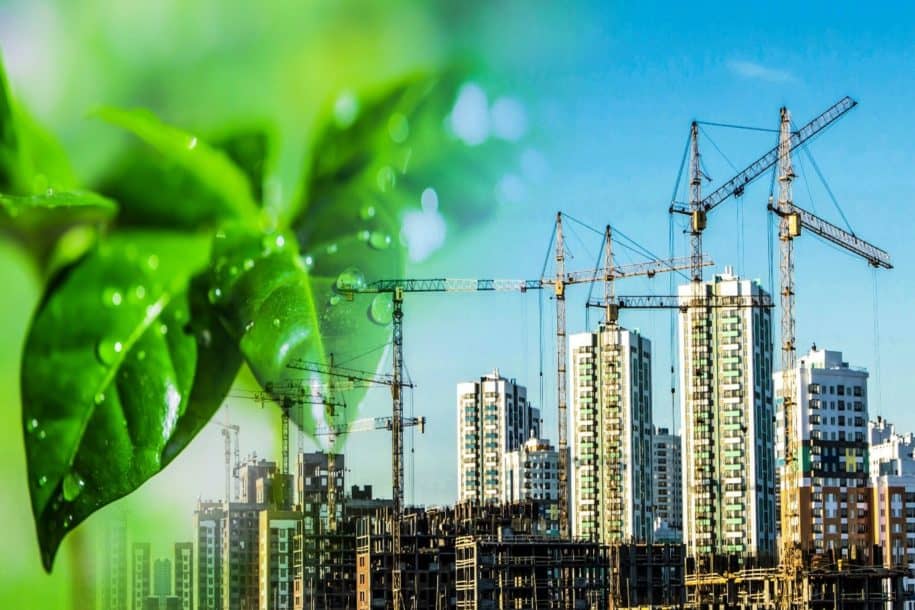Despite many construction projects being labelled as “green” projects, the impacts of construction on the environment should always be taken into consideration throughout the entire lifespan of the construction project. During the construction phase of a project, waste management is viewed as the main environmental impact, however there are plenty other environmental concerns during construction that must be considered and addressed. Every stage of any construction project has a measurable impact on the environment: the use of raw materials, transportation of materials from source to the building site, the environmental footprint of the construction site, use of water, as well as waste removal and disposal. Construction activities have drastically changed our landscapes since the Industrial Revolution. Tall buildings tower above our streets, mines drill down deep into the Earth’s crust, valleys are built up to allow for the construction of dams, and slopes are flattened for housing developments. All these activities can potentially result in environmental degradation and pollution. It is crucial that project managers, environmental health and safety officers, and site managers understand how construction projects impact the environment, as well as how these impacts can be mitigated and reduced.
Energy Efficiency
Construction projects demand a high amount of energy. Fuel (e.g., petrol and diesel) and electricity, is required for the transportation of materials, machinery, and generators as well as the maintenance of the site camp. It is therefore important to increase the energy efficacy of the project, which can be done by using modern technology and ensuring proper maintenance of machines and equipment on site.
There is a great demand on scientists and architects to meet the rising energy consumption rate with clean energy solutions. According to the United State Green Building Council, the construction industry currently accounts for 40% of worldwide energy usage, and this is expected to increase in the future. To ensure sustainable development, construction and design should allow for energy efficiency from the earliest stages of the project.
Pollution Management
All construction projects generate waste. This can be in the form of builders’ rubble, hazardous waste, or general plastic litter and food waste from the workers on site. It is critical that a thorough Waste Management Plan is drafted prior to the commencement of construction. This would detail the sources of waste, the methods of disposal, and the recommendations for how to recycle or reuse waste on site. To avoid continuous trips to a waste disposal facility, many site officers construct a “waste cage” at the site camp where waste is temporarily stored within an impermeable, weatherproof cage or container until it can be properly disposed of.
Another type of pollution that results from construction activities is noise pollution. Noise can result from machinery that is not properly silenced, loud music on site, or excavations and drilling operations. If there are sensitive receptors close to the site, construction managers should comply with local working hours so as not to cause undue disturbance.
Sustainable Use of Resources
Whether a dam or a high-rise tower is being constructed, projects require a lot of raw and natural materials. This includes wood products, limestone, building sand, clay, metals (such as electrical wiring and structural steel), and water (potable and non-potable). Some of the materials (e.g., clay for a dam wall) can be sourced on site but most often the materials must be sourced from elsewhere and transported to site. The use of raw materials has a large impact on natural ecosystems and diversity. Prior to construction, an analysis with regards to material consumption (and how it can be minimized) must be undertaken.
Construction Projects and Water
No construction project can be undertaken without the use of water. It is important that construction water be sourced from a non-potable source, such as a nearby water treatment plant or authorized boreholes, to reduce the environmental impact.
During the construction and operational phases, surface runoff should be considered and factored into the design of the project. This can be done through the drafting and implementation of a Storm Water Management Plan, which addresses how storm water and surface run off will be retained or channelled to minimize the impact on the surrounding environment during heavy rain incidents. Surface runoff has the potential to contain hazardous chemicals when flowing across a construction site. Therefore, this water should be prohibited from flowing freely into the surrounding environment.
Water used as painter’s wash water, or water used for cleaning of cement mixers and machinery, must be disposed of correctly. This water is considered hazardous due to the toxins and chemicals it contains. One option to handle this water is to collect it in an impermeable bunded area where it is allowed to evaporate and the debris and sediment can be collected and disposed of at a licensed waste disposal facility. The water can also be directly captured from the source, treated as hazardous waste, and disposed of accordingly.
The Future for Environmentally Conscious Construction
The consideration of environmental impacts and the reduction of environmental effects of construction projects requires collaboration from a vast array of stakeholders. Legislation should ensure that the environment is not unduly harmed during the approval phase of a construction project, and construction firms should take initiative to research the most sustainable construction techniques. Contractors must be held responsible for drafting management plans for waste and water, ensuring their machines are up-to-date, and sourcing sustainable materials for use on site. New technology can also be used to manage and track environmental regulatory compliance, waste disposal, and other essential environmental, health and safety data.
Author Bio
The SafetyStratus Research Advisory Group (RAG) brings together thought leaders from the global environmental, health and safety community to promote best practices and provide key insights in the profession and the industries they serve. The Research Advisory Group also advocates, where practical, the intersection of and advances with the use of technology, such as the SafetyStratus enterprise EHS software platform. Group membership consists of representatives from across varied disciplines and market sectors as well as select members of the SafetyStratus team.
The primary objectives of the SafetyStratus RAG partnership are to:
- Build a strategic partnership between EHS practitioners and the SafetyStratus team.
- Provide engaging and practical content to the global EHS community.
- Provide discipline and market feedback specific to SafetyStratus products and services.
While the objectives of the RAG are varied, the primary public-facing outcome will be available through engaging and practical content found on the SafetyStratus resource pages. Various articles, papers, and other valuable resources will be produced and shared as part of an ongoing effort to cultivate a robust community. Ultimately, the SafetyStratus RAG will expand to have a broader reach and provide opportunities for more inclusion by all interested EHS professionals in a collaborative community environment.



